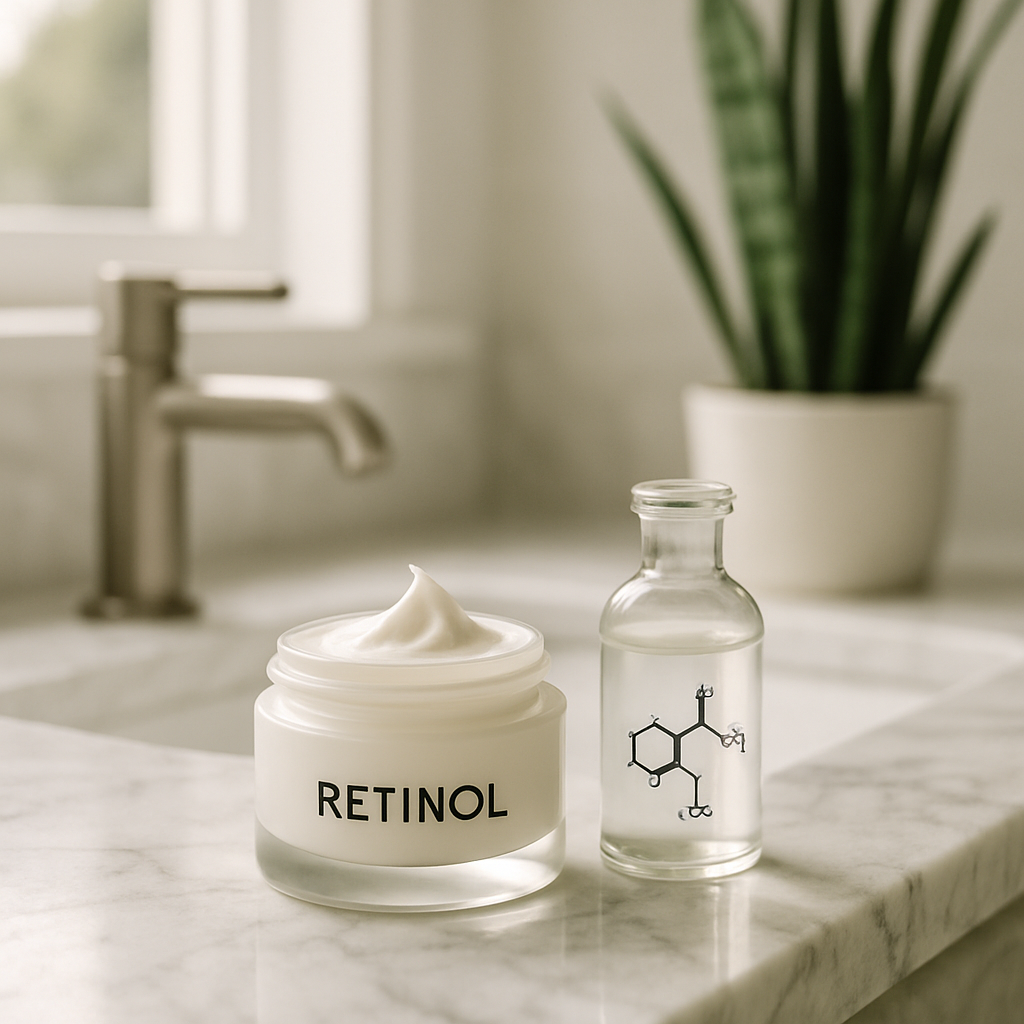
Retinol has become that one skincare ingredient everyone seems to be talking about. From TikTok to fancy dermatology clinics, it’s being praised as the gold standard for anti-aging and skin transformation. But what exactly makes this vitamin A derivative so special? And why does our skin respond to it so dramatically? Let’s break down the science without getting too textbook-y about it.
I first discovered retinol when my skin freaked out after college. Those persistent breakouts that wouldn’t budge? My dermatologist handed me a prescription retinoid and within weeks, I noticed changes I couldn’t believe. That experience sent me down a rabbit hole of research that I’m excited to share with you.
What Retinol Actually Is (Not Just Marketing Hype)
Retinol is a form of vitamin A, one of those fat-soluble vitamins our bodies need. When we talk about retinol in skincare, we’re referring to a specific type of retinoid. The retinoid family includes several compounds derived from vitamin A from gentle over-the-counter options like retinol to prescription-strength tretinoin.
The magic happens when retinol converts to retinoic acid on your skin. This conversion process is why retinol typically works more gradually than prescription retinoids, which are already in their active form. Your skin cells have special receptors that recognize retinoic acid, allowing it to communicate directly with your cell’s DNA. Pretty wild, right?
This isn’t just fancy science talk this molecular communication is why retinol can influence so many different aspects of your skin function. It’s like that friend who somehow knows everyone and can make things happen behind the scenes.
But here’s something many beauty brands won’t tell you: pure retinol is extremely unstable. It breaks down when exposed to light and air, which is why quality formulations matter tremendously. That cute clear bottle of retinol serum? Probably not doing much if it’s been sitting on your vanity for months.
Last summer, I splurged on an expensive retinol serum that came in a clear glass dropper bottle. Big mistake! It oxidized within weeks, turning a yellowish color that definitely wasn’t doing my skin any favors. Now I only buy retinol products in opaque, air-tight packaging.
The Transformation Process (And Why Patience Pays Off)
When retinol gets to work, it triggers a cascade of changes in your skin. First, it speeds up cell turnover the process by which your skin creates new cells and sheds old ones. Normal skin cell turnover takes about 28 days, but this slows as we age (which explains why kids have that effortless glow and smoothness).
Retinol pushes your skin to cycle faster, bringing fresh cells to the surface more quickly. This is why many people experience that infamous “retinol purge” when first starting out. Your skin is literally pushing all the gunk and congestion to the surface faster than normal.
My roommate gave up on retinol after just two weeks because of purging. “My skin looks worse!” she complained. I begged her to stick with it, but she’d already moved on to the next TikTok-trending ingredient. Six months later, I’m getting compliments on my skin texture while she’s still hopping between products.
Beyond cell turnover, retinol stimulates collagen and elastin production. These are the proteins that give your skin its bounce, firmness, and structure. By your mid-20s, collagen production naturally begins declining by about 1% each year. Retinol helps counteract this by telling your fibroblasts (the cells that make collagen) to get back to work.
It also thickens the deeper layer of your skin while thinning the outer dead layer. This might sound contradictory, but it’s actually brilliant you want a strong, thick dermis (the living layer) and a refined, thin epidermis (the outer layer).
A 2019 study published in the Journal of Cosmetic Dermatology found that subjects using 0.5% retinol three times weekly for 12 weeks showed significant improvement in fine lines, pigmentation, and skin texture. The researchers documented a 40% increase in glycosaminoglycan content (molecules that help keep skin hydrated) and a measurable thickening of the dermis.
But the transformation isn’t overnight. The full benefits of retinol typically take 8-12 weeks to become visible, with continued improvement over 6-12 months. This is why consistency matters more than concentration for beginners.
The Real Benefits Your Skin Gets
Let’s talk about what retinol actually does for your skin beyond the marketing claims:
Anti-aging effects: Retinol stimulates collagen and elastin production, which helps minimize fine lines and prevents new wrinkles from forming. It also reorganizes existing collagen for better structural support.
Acne treatment: By normalizing cell turnover, retinol prevents the clogging of pores that leads to breakouts. It also has anti-inflammatory properties that help with active acne.
Pigmentation correction: Retinol inhibits the enzyme tyrosinase, which is involved in melanin production. This helps fade dark spots, sun damage, and post-inflammatory hyperpigmentation.
Refined skin texture: The increased cell turnover leads to smoother, more even-textured skin with smaller-appearing pores.
Enhanced product absorption: By refining the skin’s surface, retinol can improve how well your other skincare products penetrate and work.
I was shocked when retinol helped fade a stubborn dark spot I’d had since a bad breakout in 2019. I’d tried vitamin C, niacinamide, and even those sketchy “brightening” creams from Amazon (don’t judge me), but three months of consistent retinol use did what nothing else could.
The science backs this up. A 2015 study in the Journal of Drugs in Dermatology found that retinol was effective at improving multiple signs of aging simultaneously something few other ingredients can claim.
Dr. Shereene Idriss, a NYC dermatologist, explains that retinol is unique because it works at a cellular level rather than just treating surface concerns. “It’s not just about what you see in the mirror today,” she says, “but how your skin functions and regenerates over time.”
The retinol benefits aren’t just cosmetic either. Research suggests regular use can help with skin health markers like increased hyaluronic acid production, better moisture retention, and even some photoprotective effects (though you absolutely still need sunscreen!).
But let’s be real retinol isn’t perfect. The potential for irritation, dryness, and sensitivity is real, especially when you’re starting out. My skin turned into a flaky mess the first time I tried using retinol daily. Now I know better and build up slowly.
The infamous “retinization period” (that adjustment phase where your skin might get red, dry, or flaky) happens because retinol accelerates cell turnover before your skin has adjusted its natural moisture production. Your skin essentially needs to catch up to its new turnover rate.
Starting with a lower concentration (0.25-0.3%) and using it just 2-3 times weekly helps minimize this adjustment period. Gradually increasing frequency before increasing strength is the smart approach. And yes, applying moisturizer before retinol (called buffering) really does help reduce irritation without significantly compromising results.
Most dermatologists agree that nearly everyone (except pregnant or breastfeeding women) can benefit from some form of retinoid in their routine. The key is finding the right formulation and strength for your specific skin concerns and sensitivity level.
For beginners, retinol esters (like retinyl palmitate) provide the gentlest introduction. True retinol offers a middle ground, while prescription retinoids like tretinoin deliver the most dramatic results but with potentially more irritation.
I started with The Ordinary’s 0.2% Retinol in Squalane and worked my way up to prescription tretinoin over two years. My skin would have freaked out if I’d jumped straight to the prescription strength!
The beauty of retinol is that it continues to improve your skin the longer you use it. A 2016 study found that subjects showed continued improvement even after one year of consistent retinol use. Unlike some ingredients that plateau in effectiveness, retinol keeps working.
Retinol truly stands apart in the crowded skincare market because it has decades of research supporting its benefits. While new buzzy ingredients come and go, retinol has remained the dermatologist-recommended gold standard for a reason it works at a fundamental level to change how your skin functions.
If you’re considering adding retinol to your routine, start slow, be patient, and don’t forget your sunscreen (retinol can increase sun sensitivity). Your future skin will thank you for it. And unlike that random TikTok ingredient that’ll be forgotten next month, retinol has earned its permanent place in the skincare hall of fame through solid science and consistent results.

